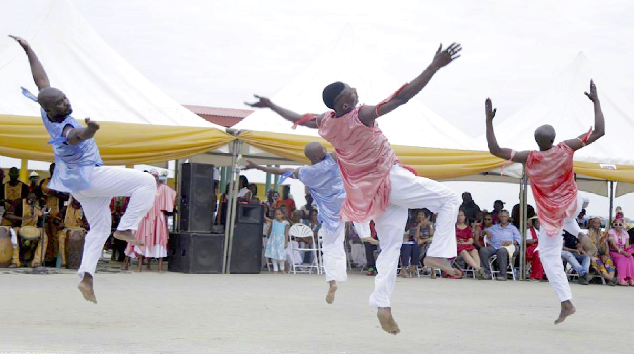
Ghana Dance Ensemble
For most Ghanaian and African societies, dance is a way of life. Traditionally, it forms an integral part of our lives, serving as a means of unification within the community, as well as a means of communication. Nearly everyone dances — at funerals, marriage and naming ceremonies, parties, initiation rites, and at various festivals. Some dances are done to show respect, others to affirm social status, to express religious beliefs or personal feelings such as joy, sorrow, hostility, or friendship.
In Ghana, the national dance company, Ghana Dance Ensemble, was established in the early 1960s as an experiment between Ghana's educational and governmental systems, to promote Ghanaian culture and national unity through dance. The Ensemble, by preserving traditional music and dance through contemporary, theatrical and creative presentations at various occasions, has been a driving cultural force in Ghana for over 60 years.
Advertisement
Background
After Ghana gained independence in 1957, the nation's first president, Dr Kwame Nkrumah, acknowledged the power of the arts, including dance, as a common denominator of his people. He believed that the cultural emancipation of Ghana, in particular, and Africa in general, was linked to its traditional arts.
In addition, Dr Nkrumah believed that the strong sense of community fostered through the traditional arts could work on a national level, contributing to the building and unification of the new nation.
In 1959, he established a National Arts Council to foster, improve and preserve the traditional arts and culture of Ghana and examine the practical ways and means to encourage a National Theatre Movement, which at once reflects the traditional heritage of the country.
Messers J. H. Kwabena Nketia, an ethnomusicologist, and Albert M. Opoku, a choreographer and dancer, were appointed to find the best ways of employing Ghanaian traditional dances for new artistic development. The two were to establish a National Dance Company, in connection with a school, in order to unite Ghanaians from different cultural backgrounds through the common denominator of the dance, which could then be performed on national events.
Initially, Kumasi, the Ashanti Regional capital, was considered as the home base for this national dance school and company, because of its central location. However, Accra was finally chosen for its proximity to the seat of government, in order to keep the company near for performances on official occasions.
Nketia and Opoku designed a certificate course at the University of Ghana, Legon, to provide dancers with the requisite training.
After an auditioning following advertisements in the local newspapers in search of candidates with a good basic education and aptitude for the dance, 13 young men and women, not less than 18 years or more than 25 years old, were selected to undergo rigorous training for a period of two years in dance techniques and theatre studies, to join the National Dance Company.
Other Trending Stories
During their two-year training period, the group travelled to numerous towns and villages across the country to learn original dances and drumming in the traditional setting.
In October 1964, the first students completed their certificate course and officially formed the National Dance Company of Ghana, called the Ghana Dance Ensemble.
The group represented Ghana at the Dakar festival in 1966 as ambassadors of culture. Thereafter, they embarked on a six-country Eastern European tour, as well as other politically-orientated performances in Moscow and Leningrad (St Petersburg) and an appearance at the 1968 Olympic Games in Mexico.
The Ghana Dance Ensemble relocated to the newly built National Theatre in 1994 and has continued its role as the professional, national dance company of Ghana.




